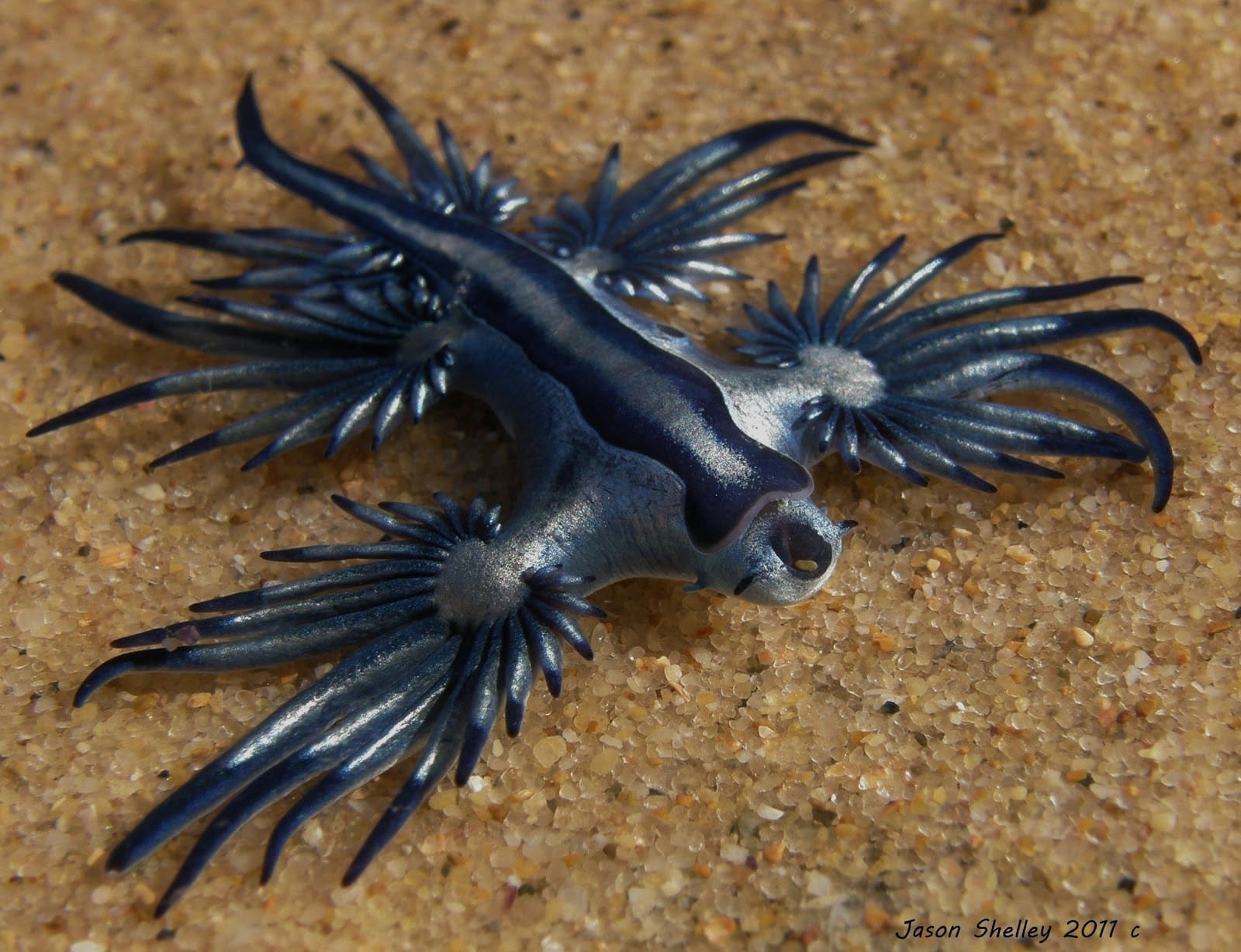Get ready for the invasion of the blue sea dragons! These mind-blowing creatures are taking over Outer Banks beaches. They’re gorgeous and venomous, and they’re mesmerizing beachgoers with their beauty. Let’s dive into their world and discover what’s behind their recent beach boom. We’ll explore their amazing adaptations, how they use their venom, and why we’re seeing more of them lately. Blue sea dragons: they’re the ocean’s most captivating secret, and we’re thrilled to share their story.
Unveiling the Enigmatic Blue Sea Dragon
Imagine a creature barely the size of your thumb, resembling a tiny, shimmering dragon from a fantasy movie, floating effortlessly on the ocean’s surface. That’s the blue sea dragon, a creature as beautiful as it is venomous.
This small but mighty creature boasts a silvery-gray back, providing camouflage against the sunlight when viewed from above. Flip it over, and you’ll be captivated by its vibrant blue belly and those electric-blue stripes on its head – the perfect disguise against the ocean floor when viewed from below. Talk about being dressed to impress, no matter which way you’re looking!
These tiny dragons are globetrotters, riding the ocean currents in tropical and subtropical seas all over the world. Surprisingly, they float upside down! This unusual lifestyle allows them to feed and even reproduce right there on the open ocean waves.
But don’t let their delicate looks fool you. The blue sea dragon is a fearless predator with a dangerous diet. They feed on venomous jellyfish – even the dreaded Portuguese man o’ war. The blue sea dragon has the incredible ability to steal the stinging cells, or nematocysts, from its prey, storing them in its own feathery appendages, known as cerata. It’s like a walking, or rather, floating, arsenal!
Of course, you’re probably wondering what happens if you get too close. Well, touching those feathery appendages will trigger a release of the stinging cells, and let’s just say it won’t be pleasant! It’s similar to a Portuguese man o’ war sting, definitely painful, but thankfully not usually deadly for us humans. Still, best to admire these beauties from a safe distance!
But there’s more to the blue sea dragon than meets the eye. They play an essential role in keeping the ocean’s ecosystem in check. By preying on jellyfish, including those pesky stinging ones, they help keep populations balanced. So, their presence is actually a good sign, telling us about the health of our oceans.
Sadly, there’s still a lot we don’t know about these captivating creatures. We’re not even sure if their populations are in danger! Pollution, climate change, and habitat destruction are potential threats to their survival, just like for many other marine animals. But scientists are working hard to learn more and ensure these little dragons continue to grace our oceans for years to come.
Is the Blue Sea Dragon Venomous?
Absolutely! These tiny, dazzling creatures might look like something out of a dream, but don’t let their beauty fool you. The blue sea dragon, floating around in the vast ocean, packs a powerful, venomous punch.
They are masters of borrowing defenses, stealing the stinging power from the venomous Portuguese Man O’ War jellyfish! Imagine stealing your enemy’s weapon and using it for yourself; that’s the blue sea dragon for you.
These dragons possess special sacs on their bodies where they store the stinging cells, called nematocysts, from the jellyfish they eat. It’s like keeping a stash of super-powered darts! When threatened, they release these stinging cells, causing a world of hurt to their attacker.
What happens if you get stung? Imagine the worst bee sting you’ve ever had, then multiply that by ten! We’re talking intense pain, redness, and swelling, maybe even nausea and vomiting. Not a fun day at the beach!
The good news is, blue sea dragons aren’t out to get us. They’re pretty chill creatures, actually. They only sting defensively if they feel threatened. Still, it’s always best to admire them from a distance.
If you ever do find yourself on the wrong end of a blue sea dragon sting, don’t panic! Rinse the area with vinegar or hot water (as hot as you can handle) to help break down the venom. If you can see any tentacles, carefully remove them with tweezers or a gloved hand. A cold compress can help with the pain and swelling. Most importantly, get yourself to a doctor, especially if the symptoms stick around or get worse.
Even though they can pack a punch, blue sea dragons are super important to the ocean’s ecosystem. By snacking on venomous jellyfish, they help keep things in balance. Plus, let’s be honest, their unique way of getting venom is pretty darn cool!
So, the next time you’re lucky enough to be near the ocean, keep an eye out for these fascinating creatures. Just remember, admire their beauty from afar and let them go about their business. They might be small, but they’re a powerful reminder that the ocean is full of surprises!
What Happens if You Get Stung by a Blue Sea Dragon?
Imagine this: you’re swimming along, enjoying the beautiful underwater scenery, and suddenly, ouch! You might have just had an unfortunate encounter with a blue sea dragon. These creatures aren’t your fire-breathing, mythical kind of dragons, but their sting can certainly pack a punch. They’re small, almost dream-like with their silvery blue coloring, but don’t let their appearance fool you.
Blue sea dragons are masters of borrowing defenses. They gather stinging cells from jellyfish, particularly the Portuguese Man-of-War, and store them in those beautiful, feathery appendages. So, if you accidentally brush against one, those borrowed stinging cells can release their venom, leaving you with a painful reminder to admire them from a safe distance.
The severity of a blue dragon sting can vary from person to person. Think of it like bee stings – some folks are just more sensitive than others. Generally, you’re likely to experience pain, redness, and maybe even some itchy welts around the sting site. Some people might feel a bit nauseous or even vomit.
In more serious cases, some people might have a strong allergic reaction, making it hard to breathe, which is a sign to get medical help immediately. This severe reaction is called anaphylaxis, and it’s nothing to mess around with.
So, let’s say you do get stung. What should you do? First things first, try to carefully remove any tentacles that might be stuck to your skin. Tweezers are great for this, but if you don’t have any handy, wearing gloves or using a cloth will work. Whatever you do, resist the urge to rub the area, especially with fresh water. This can actually make the sting worse by triggering the release of more venom.
Next, you’ll want to neutralize those stinging cells. Rinsing the area thoroughly with vinegar or hot water for at least half a minute can help. Afterwards, a cold compress can work wonders in reducing swelling and easing the pain.
Remember, even if a blue sea dragon is no longer alive, it can still sting! That venom stays potent, so it’s best to avoid handling them altogether.
Here’s the bottom line: blue sea dragons are fascinating creatures, but it’s best to appreciate their beauty from afar. Their stings, while usually not life-threatening, can definitely put a damper on your day. Being aware of their venomous defense mechanism and knowing what to do if you get stung can help you stay safe and enjoy all the wonders the ocean has to offer.
Can the Blue Sea Dragon Be a Pet?
So, you’re captivated by the blue sea dragon, right? Who wouldn’t be? They look like something out of a dream, floating through the ocean like shimmering blue jewels. But before you get any ideas about scooping one up for a personal aquarium, let’s talk about why that’s probably not the best idea.
These stunning creatures might be small and beautiful, but they are also highly specialized predators. Imagine trying to keep a creature that eats only the world’s spiciest chili pepper – that’s essentially the challenge of feeding a blue sea dragon. They have a very particular diet, feasting exclusively on venomous jellyfish-like creatures called siphonophores, particularly the infamous Portuguese Man-of-War. Not exactly something you can pick up at the pet store!
And here’s the kicker: blue sea dragons don’t just eat the venom, they store it! Think of it like a defense mechanism, except their version of “watch out!” is a mouthful of concentrated jellyfish stings. So, even if you could somehow replicate their diet (which, trust me, you can’t), handling them would be like playing with fire – beautiful, mesmerizing fire that leaves you with incredibly painful welts.
Beyond the dietary impossibilities and venomous defenses, providing a suitable living space for a blue sea dragon is another massive hurdle. Imagine trying to recreate the open ocean in a fish tank – it’s just not feasible. These animals are built for vast expanses of water with very specific salinity and temperature ranges. Confining them to a tank would not only be incredibly difficult, but it would also cause them a great deal of stress and likely lead to health problems.
And then there’s the ethical side of things. Capturing blue sea dragons from their natural environment disrupts delicate ecosystems and puts pressure on their populations, which are not fully understood. We don’t know enough about their numbers in the wild, and taking them for personal enjoyment simply isn’t a risk worth taking.
Some people might argue that responsible breeding programs could offer a solution, but even then, keeping a blue sea dragon in captivity raises moral questions. These animals aren’t meant to live out their days in a glass box, no matter how spacious or well-maintained. They are highly evolved creatures with complex social behaviors and intricate relationships with their environment, all of which are impossible to replicate in captivity.
So, while the idea of having your own miniature sea dragon might be tempting, it’s important to prioritize the well-being of these incredible animals and respect the delicate balance of our oceans. Instead of trying to confine them to our homes, let’s focus on supporting conservation efforts, responsible marine wildlife observation, and educational initiatives that promote the preservation of these captivating creatures in the wild where they belong.
What Eats a Blue Sea Dragon?
We know the blue sea dragon, that tiny, poisonous slug that chills upside down in the water, has a pretty wild diet. But who’s munching on them? Turns out, in the vast ocean, even something that looks like a tiny, swimming dragon can end up as someone’s lunch.
The main predator of the blue sea dragon is the loggerhead turtle. These turtles aren’t picky eaters – they gobble down jellyfish, crabs, fish—you name it. If a loggerhead turtle stumbles upon a blue sea dragon, it’s probably going down the hatch in one gulp.
But it’s not just loggerheads on the lookout for a blue sea dragon snack. Large fish that roam the open ocean and even some seabirds might see a blue sea dragon bobbing on the surface and think, “Hey, easy meal!”
Now, you might think being small would make the blue sea dragon an easy target. But they’ve got some tricks up their, well, non-existent sleeves! Their vibrant blue color is a big, flashing warning sign that screams, “Back off! I’m poisonous!” And if that wasn’t enough, they have those finger-like extensions called cerata, which are basically tiny venom-filled weapons. Any predator that tries a taste test is in for a painful surprise.
Even though they’re small, these little dragons are important players in the ocean’s ecosystem. They help keep those pesky jellyfish populations in check, which can be a real pain for other marine life. And, of course, they become a meal for bigger creatures like our loggerhead friends. It’s the circle of life!
Did you know nature is full of unusual and fascinating creatures like beautiful butterflies, a bee beard is a real thing, and the shoebill is actually a real bird? Did you know that the goliath birdeater can be kept as pets, the black giraffe is a rare type of giraffe, the black swallower is not as frightening as it sounds, the blue tarantula is a quite rare species of tarantula, and the Border Collie is a real thing?
- Unveiling Bernhard Caesar Einstein’s Scientific Achievements: A Legacy in Engineering - July 15, 2025
- Uncover who is Jerry McSorley: CEO, Family Man, Business Success Story - July 15, 2025
- Discover Bernhard Caesar Einstein’s Scientific Contributions: Unveiling a Legacy Beyond Einstein - July 15, 2025















